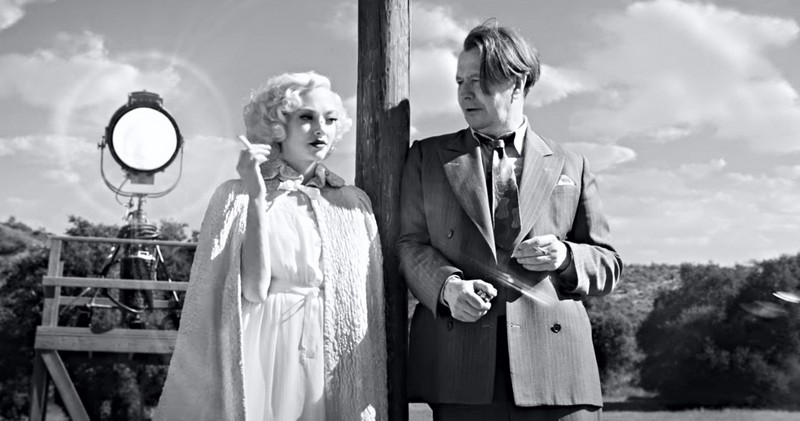Ghosts of old Hollywood and demons of contemporary life both hang heavy over David Fincher’s Mank. This ostensible biopic of Citizen Kane screenwriter Herman J. Mankiewicz does a great job of exploring a troubled character struggling with his problems and his art. But it also delves into what Fincher sees as the root of America’s (and, to an extent, Australia’s) political malaise – power and money corrupting public discourse, and thus, the democratic process. This dual nature means the film tries to do a lot in a limited time. So while its ambitions are lofty, it never really settles into a neat groove as it flip-flops between its elements.
Fincher seeks to do to Mankiewicz what Mankiewicz did to William Randolph Hearst in Citizen Kane – to explore what drives someone to greatness. Citizen Kane posits that childhood trauma drove the rise of Charles Foster Kane to power. Mank suggests politics – and particularly a dirty tricks campaign orchestrated by Hearst – created a rift between Mankiewicz and Hearst. The resulting enmity in turn drove Mankiewicz to write his opus magnus in Citizen Kane.

The theory contains elements of truth. Mankiewicz certainly moved in Hearst’s inner circle. He was also a famous wit – an a raging alcoholic as the film depicts. But just how close he and Hearst were and what really went into the Citizen Kane script aren’t necessarily all that clear. For example, the Kane character is generally accepted to be a composite of Hearst and others, notably Joseph Pulitzer. If that’s right, then Mank’s theory loses steam.
The film opens in 1940 with Mankiewicz (Gary Oldman) disabled after a car accident. He’s ensconced in a room with a secretary Rita Alexander (Lily Collins) and a nurse Fraulein Freida (Monika Grossman). His only task for the next 60 days is to write a script for Orson Welles (Tom Burke). The “wunderkind” director has been given free rein by RKO for his upcoming film project. It needs to be special. Mank has left his wife Sara (Tuppence Middleton) and kids behind to take the job. In the sweltering LA heat, Mank rants, cajoles and drinks. But as the clock ticks, he labours on the screenplay to little effect. Through a series of flashbacks, he recalls his relationship with William Randolph Hearst (Charles Dance), his loyal lieutenant Louis B Mayer (Arliss Howard) – and Hearst’s mistress, the actress Marion Davies (Amanda Seyfried).
Oddly, the screenplay credit names Jack Fincher – the director’s father – as the screenwriter. But Jack passed away in 2003 – and this appears to be his only screenplay credit. Is Fincher playing games with us, in much the same way Mankiewicz plays games in the film? While it’s of course possible Jack wrote the script while he was alive, it the situation has a whiff of David’s trademark twists about it.
Fincher structures the film similarly to Citizen Kane. It jumps back and forward in time. Screenplay-style titles set each new time frame, but I found it got a little confusing after a while. Just to add to its layers, Mank also charts Mankiewicz’s relationships to three women – Sara, Rita and Marion. DOP Erik Messerschmidt (Mindhunter) shoots in black-and-white, giving the film a very 1940s (dare I say Citizen Kane-like) feel. Maybe it was the cinema where I saw it, but occasionally it looked a bit murky at times. The 1940s feel continues with a surprising, jazz-flecked score by frequent Fincher collaborators Trent Reznor and Atticus Ross. And did I notice allusions to several other Golden Era classics, including Rear Window?
Maybe it’s just me, but I liked the old Hollywood stuff more than the politics in Mank. When it was getting into the relationships between the characters, I was with it all the way. But once the political elements were introduced in the second half of the film, they felt didactic and rather forced. And while I fully get their relevance in 2020, it’s not like they’re saying anything new.
Gary Oldman (The Laundromat) once more shows why he’s one of the preeminent actors of his generation. As you might expect, he plays the multi-faceted Mank with assurance and elan. Lily Collins (Emily in Paris) brings a very British sensibility to the long-suffering Rita. The wonderfully-named Tuppence Middleton (Downton Abbey) brings unexpected vibrancy to the character of Sara. Arliss Howard is terrific as the obsequious Mayer; while Charles Dance lends his vaunted gravitas to Hearst. And Amanda Seyfried (Mamma Mia! Here We Go Again) shines as Marion.
I loved large bits of Mank. As a portrait of its titular character, it’s simply brilliant. As a re-creation of 1940s Hollywood, it’s a winner. But as a political polemic, I could take it or leave it. Amazingly, this is Fincher’s first feature film since Gone Girl (2014). And it’s quite a re-introduction for this major filmmaking talent. Once more he shoots for the moon; and even if this falls a little short of his goal, it’s worth seeing just to witness the master back at the helm.
Mank is in cinemas (where open) now and will be available on Netflix from 4 December 2020
David Edwards
Other reviews you might enjoy:

David Edwards is the former editor of The Blurb and a contributor on film and television





